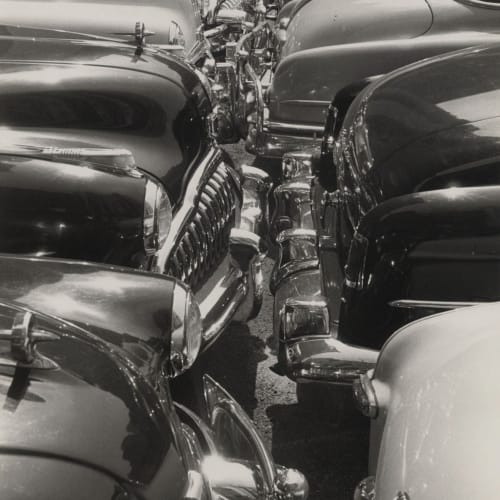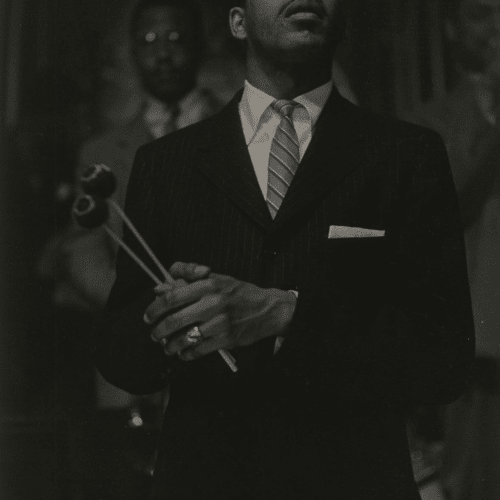Jenkins Johnson Gallery is excited to exhibit the work of ROY DeCARAVA at Art Basel Miami Beach, one of the worlds premier art shows for modern and contemporary works, at Miami Beach Convention Center, December 3 – 6, 2015. Featured in Survey, DeCarava’s photos are one of fourteen historical projects in focus at Art Basel for works made before 2000. Sherry Turner DeCarava, the leading art historian on his life and work, will speak in the booth Friday, December 4 at 1 pm.
Jenkins Johnson Gallery will present the largest body of DeCarava’s photographs on view in nearly 10 years. The exhibition will include portraits of jazz legends, scenes of everyday life in New York from the 1940s to1980s, rare work from the award-winning book he coauthored with the poet Langston Hughes, The Sweet Flypaper of Life (1955), as well as ruminative portraits of the sound and meaning of jazz from his cognoscenti-revered book entitled the sound i saw (2001).
Roy DeCarava (1919 - 2009), a lifelong New Yorker, was one of the great pioneers in the 20th century movement toward modern American Art. He has influenced generations of image-makers, including Carrie Mae Weems, Kerry James Marshall, and Hank Willis Thomas, among others, while expanding the values for artistic photography through an approach to intrinsic gesture and establishing equal significance for the subtle expression of subject.. Through his work he profoundly shaped our understanding of the people and places he photographed. Over a six decade-long career, he created from the immediacy of improvisation, images that are so flawlessly structured and formally elegant, as to appear deceptively simple. Yet, startlingly rich in a tonal palette that often explores unplumbed hues, DeCarava’s photographs map out a creatively centered flow of poetic thought and vision. His images probe the emotional timbre of a city, the inner lives of its inhabitants and illuminate moments made extraordinary by his mastery of “an infinite palette of greys,” an apt phrase he coined that brings the viewer closer to his attentive eye and devotion to the medium of silver gelatin.
From the beginning, DeCarava eschewed the standard schools of photographic thought in favor of his own iconoclastic vision. He was neither interested in the documentary or in journalism; he set aside the commercial as well as the street photography of a “New York School.” Instead, his work defines a distinct position in American Art that was of interest to only a few other photographers (with diverse subjects and visions) such as the astute Irving Penn and the modernist Harry Callahan. DeCarava quietly but more directly maintained that photography as an art was an endeavor of spiritual experience and, in its compounding levels of visual and social revelation, had challenges and rewards for the practitioner unlike any other visual medium. Fully immersed in this world, working by his own hand, he discovered a process that enabled him to summon imagery into elegiac metaphor and temporal resonance.
Exclusively using natural light and working without assistants, DeCarava printed his own photographs throughout his career. The works selected for Art Basel Miami Beach are a strong selection of vintage prints whose patina and tonal range highlight the mastery of DeCarava’s printing process, from the illumination of a young child whose face summons echoes of African art, to the photographer’s pursuit of an uncharted cosmos in the optical mystery of a subway station. His images achieve both a resolute quality of truth and a poised visual elegance without losing their daring impulse. In Coltrane #24 DeCarava fuses painterly concerns into the creative engine of human music endeavor, fusing to the coordinates of photographic and other-worldly time. Many of his photographs forge new connections between people and their environments in ways which serve to effectively shift and upend expectations by setting the viewer on a journey to “…slip unannounced into” artistic discovery.
Few artists photographed the common man as a complex individual, a carrier of beauty, like Roy DeCarava. Beginning in 1955 his work was featured in the historic exhibition, The Family of Man, shown in eighty-eight venues in thirty-seven countries on six continents. His 1969 exhibition Thru Black Eyes: Photographs by Roy DeCarava at The Studio Museum in Harlem was a milestone exhibition for African American photographers. In 1952, he became the first African American photographer to receive a Guggenheim Foundation Fellowship, and he published numerous photo essays and four books. DeCarava’s work has appeared in nearly twenty solo and group exhibitions at museums around the globe, including The Metropolitan Museum of Art, The National Gallery of Art, The Art Institute of Chicago, The San Francisco Museum of Modern Art, the Los Angeles County Museum of Art, Corcoran Gallery of Art and the Modern Museet Fotografiska (Sweden). This includes the 1996 exhibition Roy DeCarava: A Retrospective that opened at the Museum of Modern Art and subsequently traveled throughout the United States. His work was recently seen in Blues for Smoke, an exhibition in partnership with the Whitney Museum of American Art, Museum of Contemporary Art Los Angeles, and the artist Glenn Ligon in 2013. In 2014 his work was exhibited at Paris Photo and Miami Project. Earlier this year, The New York Times featured his work in “A True Picture of Black Skin.”Roy DeCarava’s photographs Elvin Jones, 1961 and Coltrane and Elvin, 1960, were exhibited in America Is Hard to See, the Whitney Museum of American Art’s inaugural show for their new building, beginning in May of this year.
DeCarava’s life and work, the subject of a Charlie Rose interview and a solo PBS documentary film, has received much professional recognition. Among his awards were the Presidential Medal of Arts in 2006 from the National Endowment of Arts, the Century Award in Photography from the San Diego Museum of Photographic Arts, and the Master of Photography Award of the International Center of Photography, New York. He and art historian Sherry Turner DeCarava were honored with the international Rencontre d’Arles French book award for the best photography and interpretive text published in 1981. His last book, “the sound i saw,” representing thirty years of his jazz photography, was published in 2001 (Phaidon Press). In April of this year Turner DeCarava spoke at the Schomburg Center for Research in Black Culture on Roy DeCarava’s life and work as part of the Schomburg’s Visually Speaking series. Turner DeCarava and Karen JenkinsJohnson are available for interviews.
“My pictures are immediate and yet at the same time, they’re forever… a moment that becomes an eternity. . . there’s an arc of being.” --- Roy DeCarava, Photographs, 1981, p. 19.




